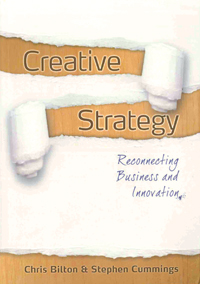
Faced with some of the most challenging budget issues for a generation, arts organisations risk the perfect storm: reduced investment from arts councils, reduced local authority investment and a public trying to implement lower-cost lifestyles. It is handy, then, that Chris Bilton and Stephen Cummings have come forward with their book ‘Creative Strategy’. As they point out, the strategic purpose of an organisation cannot be separated from its context, and we are all facing a brave new context.
The authors very helpfully set out the source of their thinking, giving the reader more insights into the challenges, structures, possible solutions and a wide range of options for arts sector problem solving. They also outline how creative business decisions can be made and the attributes that will improve our chances of success. In a time of crisis, it’s good to see the argument for business innovation being laid out in a thorough, if slightly mechanical, way.
Whilst the authors do offer a central idea to their analysis, in what they call “organisational virtues”, they wisely stop short of setting out a right and wrong approach. But, the examples they provide do offer inspiration but obvious examples are also generously shared here, for instance: how the integration of design into new products in the early part of this century allowed companies to significantly improve their performance (22% better in the case of a Dutch study in 2003). The authors’ efforts to “rouse, stimulate and refresh” our thinking extends across a variety of analogies from Radiohead to bar codes, from Bob Sutton’s frank ”11½ Weird Ideas that Work” to Aristotle.
The authors also take the time to reflect on what a large arts organisation like the Royal Shakespeare Company actually does when it creates a production; it is this concrete example that is then interwoven with theory to prove the substance. Whilst the effect isn’t overwhelmingly convincing, it does show the reader more options on problem solving.
In ‘Creative Strategy’, the authors have tried to create a structure for the reader to follow, but this isn’t a self-help management book and doesn’t claim to be: there is no 12-steps-to-success programme here, yet I defy any interested business leader to read this book and not find themselves drawing some inspiration and insights about their own organisation or team. And in an age of deepening austerity, the timing is spot on.
Review by Howard Raynor, World Class Service Ltd.
w http://www.worldclassservice.co.uk




